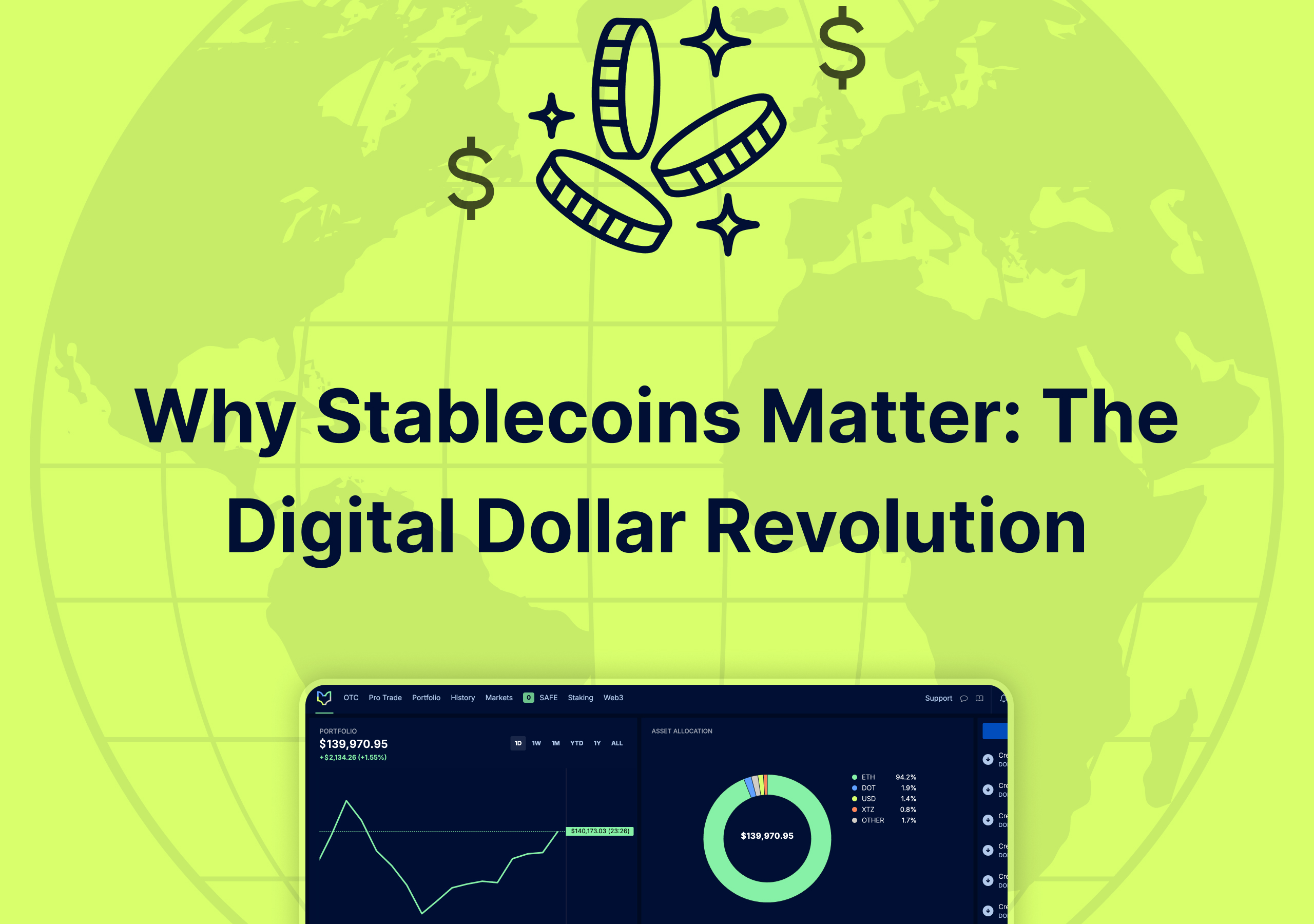Stablecoins: Why Do They Matter?
Digital currencies are reshaping finance for institutions and individuals alike
The financial world is witnessing a quiet revolution. While Bitcoin grabs headlines with its volatility and Ethereum makes waves with smart contracts, stablecoins are steadily becoming the backbone of digital finance. These dollar-pegged digital assets have grown from a niche crypto experiment to a $200+ billion market that is fundamentally changing how money moves around the world.
But why do stablecoins matter? The answer lies in their unique ability to bridge the gap between traditional finance and the digital economy, offering compelling benefits to both large institutions and everyday users.
The Institution Perspective: Efficiency Meets Scale
Treasury Management Revolution
For large corporations and financial institutions, stablecoins represent a paradigm shift in treasury management. Consider sFOX’s need to maintain banking relationships across different countries, each with its own regulatory requirements, settlement times, and fees. With stablecoins, our treasury can move millions of dollars across borders in minutes, not days, with transparency that traditional banking systems simply cannot match.
JPMorgan’s JPM Coin and Goldman Sachs’ exploration of digital assets aren’t experiments—they’re strategic responses to the clear efficiency gains stablecoins provide. When a trade settlement that traditionally takes T+ 2 days can be completed in real time, the capital efficiency gains are enormous.
With sFOX Connect, institutions can tap into those same advantages through a unified platform—streamlining onboarding, compliance, custody, and settlement so treasurers don’t just move faster, but do so with confidence.
The Signet Success Story
One of the most compelling early institutional examples was Signature Bank’s Signet platform, which showed how banks could successfully leverage blockchain technology for real-time payments. Launched in 2019, Signet functioned as a 24/7 settlement system that allowed commercial clients to transfer digital dollars instantly.
Unlike external stablecoins, Signet represented deposits directly held at Signature Bank, offering clients FDIC insurance alongside instant settlement. The platform became widely adopted across digital asset exchanges, fintechs, and corporations needing to move large sums outside of banking hours.
While its closure in 2023 was tied to regulatory challenges, Signet’s success illustrated a crucial point: the value of digital dollars isn’t limited to decentralized crypto. Even within a traditional bank, the ability to program money for always-on settlement offered corporate treasurers new levels of precision and flexibility.
Risk Management Through Distribution
Stablecoins also offer a fresh approach to counterparty risk management. Traditional FDIC insurance caps institutional deposits at $250,000 per bank—a limit that forces corporations into complex multi-bank relationships. Some issuers, like Circle, spread reserves across multiple FDIC-insured banks, effectively expanding deposit protection through a single digital asset.
A corporate treasurer managing $100 million in cash reserves might otherwise need relationships with hundreds of banks. With properly structured stablecoins, much of that diversification can be achieved through a single position—simplifying operations without compromising safety.
sFOX Connect extends that logic: by providing transparent custody and regulatory-grade reporting, it allows institutions to integrate stablecoin diversification strategies directly into their existing workflows.
Programmable Money for Complex Operations
Stablecoins aren’t just digital dollars—they’re programmable digital dollars. Smart contracts allow institutions to automate financial arrangements: escrow releases, recurring payments, conditional transfers, and multi-party settlements.
Consider supply chain finance. Traditionally paper-heavy and dependent on multiple intermediaries, it can be streamlined through stablecoin-based smart contracts that automatically release payments once delivery conditions are met. The efficiency gains compound across every process they touch.
With sFOX Connect’s developer APIs, these programmable capabilities can be embedded into custom workflows while preserving compliance guardrails.
The Future of Fund Ownership: Tokenized Traditional Finance
Perhaps the most transformative institutional application lies in stablecoins’ role in tokenizing traditional assets. We are moving toward a future where ownership of mutual funds, ETFs, or money market funds could be represented by blockchain tokens rather than account entries.
Instead of waiting for T+2 settlement, tokenized fund shares could be bought and sold instantly using stablecoins. Pension funds could rebalance in real time, moving from equities to bonds without settlement delays.
This shift opens the door to:
- Fractional investing at scale
- Automated portfolio rebalancing via smart contracts
- Programmable investment strategies that adjust based on market conditions
At sFOX, our Rebalancer platform already helps wealth managers automate allocation and portfolio management, integrated seamlessly with stablecoin settlement.
Examples like BlackRock’s BUIDL fund, representing U.S. Treasuries on blockchain, and Franklin Templeton’s OnChain U.S. Government Money Fund show that this future is already underway. These are not pilot projects—they are the early foundations of a financial system where asset ownership lives on-chain.
The End User Revolution: Access and Control
Global Banking the Unbanked
For individuals, stablecoins represent something more profound than efficiency—they represent access. Around 1.4 billion adults remain unbanked, often due to geography, economics, or regulation. A smartphone and an internet connection can now provide access to USD-denominated stablecoins, effectively functioning as a savings account and payment rail.
In countries with currency instability, citizens increasingly turn to stablecoins as a store of value. A small business owner in Argentina or Turkey, for example, can preserve purchasing power by holding USDC rather than watching local currency depreciate.
Infrastructure for the Next Financial System
Perhaps most importantly, stablecoins are building the rails for a new financial system. They are enabling:
- Automatic micropayments for content
- Real-time revenue sharing for creators
- Programmable savings that optimize for yield
Institutions gain efficiency. Individuals gain access. The system itself becomes more inclusive and resilient.
Challenges and Considerations
Stablecoins aren’t without risk. Regulatory clarity remains evolving. Issuer counterparty risk is real—reserves must be properly managed and transparent. Smart contract vulnerabilities and wallet security challenges remain.
For institutions, compliance requirements (AML, KYC) still apply. For individuals, private key management can feel daunting.
Yet the trajectory is clear: better user interfaces, institutional-grade custody, and clearer regulations are making stablecoins safer and easier to use. At sFOX, and specifically through sFOX Connect, we help institutions meet these challenges with compliance automation, segregated custody, and transparent reporting—bridging the gap between innovation and regulation.
The Path Forward
Stablecoins matter because they solve real problems for real people and businesses. They reduce costs, increase speed, expand access, and enable new business models. They are not replacing traditional finance—they are upgrading it.
For institutions like sFOX, stablecoins unlock efficiency and new opportunities. For individuals, they provide financial access and protection against instability. For the global economy, they create the foundation for a more inclusive, efficient financial system.
As money increasingly flows through digital channels, stablecoins aren’t just another instrument. They are the bridge between the financial system we have and the one we need—and with sFOX Connect, institutions have the infrastructure to adopt them safely, compliantly, and at scale.

